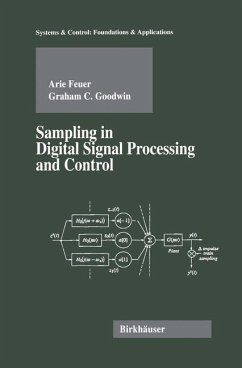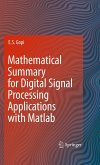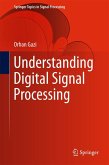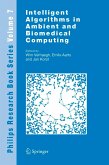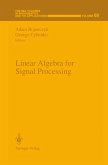- Broschiertes Buch
- Merkliste
- Auf die Merkliste
- Bewerten Bewerten
- Teilen
- Produkt teilen
- Produkterinnerung
- Produkterinnerung
Undoubtably one of the key factors influencing recent technology has been the advent of high speed computational tools. Virtually every advanced engi neering system we come in contact with these days depends upon some form of sampling and digital signal processing. Well known examples are digital tele phone systems, digital recording of audio signals and computer control. These developments have been matched by the appearance of a plethora of books which explain a variety of analysis, synthesis and design tools applica ble to sampled-data systems. The reader might therefore wonder what is…mehr
Andere Kunden interessierten sich auch für
![Unified Signal Theory Unified Signal Theory]() Gianfranco CariolaroUnified Signal Theory76,99 €
Gianfranco CariolaroUnified Signal Theory76,99 €![Mathematical Summary for Digital Signal Processing Applications with Matlab Mathematical Summary for Digital Signal Processing Applications with Matlab]() E. S. GopiMathematical Summary for Digital Signal Processing Applications with Matlab115,99 €
E. S. GopiMathematical Summary for Digital Signal Processing Applications with Matlab115,99 €![Wavelets Made Easy Wavelets Made Easy]() Yves NievergeltWavelets Made Easy38,99 €
Yves NievergeltWavelets Made Easy38,99 €![Understanding Digital Signal Processing Understanding Digital Signal Processing]() Orhan GaziUnderstanding Digital Signal Processing82,99 €
Orhan GaziUnderstanding Digital Signal Processing82,99 €![Hierarchical Methods Hierarchical Methods]() V. KulishHierarchical Methods38,99 €
V. KulishHierarchical Methods38,99 €![Intelligent Algorithms in Ambient and Biomedical Computing Intelligent Algorithms in Ambient and Biomedical Computing]() Wim Verhaegh / Emile Aarts / Jan Korst (eds.)Intelligent Algorithms in Ambient and Biomedical Computing106,99 €
Wim Verhaegh / Emile Aarts / Jan Korst (eds.)Intelligent Algorithms in Ambient and Biomedical Computing106,99 €![Linear Algebra for Signal Processing Linear Algebra for Signal Processing]() Linear Algebra for Signal Processing112,99 €
Linear Algebra for Signal Processing112,99 €-
-
-
Undoubtably one of the key factors influencing recent technology has been the advent of high speed computational tools. Virtually every advanced engi neering system we come in contact with these days depends upon some form of sampling and digital signal processing. Well known examples are digital tele phone systems, digital recording of audio signals and computer control. These developments have been matched by the appearance of a plethora of books which explain a variety of analysis, synthesis and design tools applica ble to sampled-data systems. The reader might therefore wonder what is distinc tive about the current book. Our observation of the existing literature is that the underlying continuous-time system is usually forgotten once the samples are tak en. The alternative point of view, adopted in this book, is to formulate the analy sis in such a way that the user is constantly reminded of the presence of the under lying continuous-time signals. We thus give emphasis to twoaspects of sampled-data analysis: Firstly, we formulate the various algorithms so that the appropriate contin uous-time case is approached as the sampling rate increases. Secondly we place emphasis on the continuous-time output response rath er than simply focusing on the sampled response.
Produktdetails
- Produktdetails
- Systems & Control: Foundations & Applications
- Verlag: Birkhäuser / Birkhäuser Boston / Springer, Berlin
- Artikelnr. des Verlages: 978-1-4612-7546-6
- Softcover reprint of the original 1st edition 1996
- Seitenzahl: 580
- Erscheinungstermin: 8. Oktober 2011
- Englisch
- Abmessung: 235mm x 155mm x 32mm
- Gewicht: 867g
- ISBN-13: 9781461275466
- ISBN-10: 1461275466
- Artikelnr.: 36204448
- Herstellerkennzeichnung
- Springer Nature c/o IBS
- Benzstrasse 21
- 48619 Heek
- Tanja.Keller@springer.com
- Systems & Control: Foundations & Applications
- Verlag: Birkhäuser / Birkhäuser Boston / Springer, Berlin
- Artikelnr. des Verlages: 978-1-4612-7546-6
- Softcover reprint of the original 1st edition 1996
- Seitenzahl: 580
- Erscheinungstermin: 8. Oktober 2011
- Englisch
- Abmessung: 235mm x 155mm x 32mm
- Gewicht: 867g
- ISBN-13: 9781461275466
- ISBN-10: 1461275466
- Artikelnr.: 36204448
- Herstellerkennzeichnung
- Springer Nature c/o IBS
- Benzstrasse 21
- 48619 Heek
- Tanja.Keller@springer.com
1 Fourier Analysis.- 1.1 Introduction.- 1.2 The Basic Transforms.- 1.3 Properties of Continuous-Time Fourier Transforms.- 1.4 Properties of Discrete-Time Fourier Transforms.- 1.5 The ? - Impulse Stream.- 1.6 Inter-relating the Various Transforms.- 1.7 Special Topics.- 1.8 Further Reading and Discussion.- 1.9 Problems.- 2 Sampling and Reconstruction.- 2.1 Introduction.- 2.2 Sampled Data Sequences - A Representation of Continuous Signals.- 2.3 Continuous Signal Reconstruction from a Sampled Data Sequence.- 2.4 Shannon' s Reconstruction Theorem.- 2.5 Practical Methods of Reconstruction.- 2.6 Signal Reconstruction from Periodic Samples.- 2.7 Further Reading and Discussion.- 2.8 Problems.- 3 Analysis of Discrete-Time Systems.- 3.1 Introduction.- 3.2 Shift Operator Models.- 3.3 z-Transforms.- 3.4 The Delta Operator.- 3.5 Difference Equations in Delta Operator Form.- 3.6 Discrete Delta Transform.- 3.7 Use of Discrete Delta Transforms to Solve Difference Equations.- 3.8 The Discrete Transfer Function.- 3.9 Summary of Delta Transform Properties.- 3.10 Stability of Discrete Systems.- 3.11 Discrete Frequency Response.- 3.12 Frequency Domain Stability Criteria for Discrete-Time Systems.- 3.13 Digital Filter Implementation.- 3.14 Further Reading and Discussion.- 3.15 Problems.- 4 Discrete-Time Models of Continuous Deterministic Systems.- 4.1 Introduction.- 4.2 State-Space Development.- 4.3 Transform Development.- 4.4 Continuous-Time and Discrete-Time Poles and Zeros.- 4.5 Numerical Issues.- 4.6 Frequency Domain Development.- 4.7 Further Reading and Discussion.- 4.8 Problems.- 5 Optimal Linear Estimation with Finite Impulse Response Filters.- 5.1 Introduction.- 5.2 Problem Description.- 5.3 Sampled Model.- 5.4 The Discrete Lattice Filter.- 5.5 Continuous-Time LatticeStructure.- 5.6 Relationships between the Discrete and Continuous Lattice Filters.- 5.7 Further Reading and Discussion.- 5.8 Problems.- 6 Optimal Linear Estimation with State-Space Filters.- 6.1 Introduction.- 6.2 Signal Model.- 6.3 The Sampling Process.- 6.4 Discrete Stochastic Model.- 6.5 The Discrete Kalman Filter.- 6.6 Continuous-Time State Estimation.- 6.7 Further Reading and Discussion.- 6.8 Problems.- 7 Periodic and Multirate Filtering.- 7.1 Introduction.- 7.2 Models for Periodic Linear Systems.- 7.3 The Raising Procedure.- 7.4 Frequency Domain Analysis of Periodic Filters.- 7.5 Models for Sampled Periodic Stochastic Systems.- 7.6 Periodic Optimal Filtering.- 7.7 Further Reading and Discussion.- 7.8 Problems.- 8 Discrete-Time Control.- 8.1 Introduction.- 8.2 Closed-Loop Stability and Pole Assignment.- 8.3 Some Special Discrete-Time Control Laws.- 8.4 Sensitivity and Complementary Sensitivity Functions.- 8.5 All Stabilizing Control Laws.- 8.6 State Estimate Feedback.- 8.7 Rapprochement Between State Estimate Feedback and Stabilizing Controllers.- 8.8 Linear Quadratic Optimal Regulator.- 8.9 Duality Relationships.- 8.10 Further Reading and Discussion.- 8.11 Problems.- 9 Sampled Data Control.- 9.1 Introduction.- 9.2 Mixing Continuous and Discrete Transfer Functions.- 9.3 Sensitivity Considerations.- 9.4 Modified Discrete Transforms.- 9.5 Examples.- 9.6 Observations and Comments from the Examples.- 9.7 The Class of All Stabilizing Sampled-Data Controllers.- 9.8 Linear Quadratic Design of Sampled-Data Controllers.- 9.9 Duality Relationships for Hybrid Optimal Controller.- 9.10 Further Reading and Discussion.- 9.11 Problems.- 10 Generalized Sample-Hold Functions.- 10.1 Introduction.- 10.2 Generalized Sample-Hold Function: A Time Domain Perspective.- 10.3 Other Applications of Generalized Sample-Hold Functions.- 10.4 Frequency Domain Analysis of GSHF.- 10.5 Sensitivity Considerations.- 10.6 Further Reading and Discussion.- 10.7 Problems.- 11 Periodic Control of Linear Time-Invariant Systems.- 11.1 Introduction.- 11.2 Periodic Control of Linear Time-Invariant Systems.- 11.3 Time Domain Analysis.- 11.4 Frequency Domain Analysis.- 11.5 Further Reading and Discussion.- 11.6 Problems.- 12 Multirate Control.- 12.1 Introduction.- 12.2 A Unifying Approach.- 12.3 Slow Output Sampling, Fast Input Sampling.- 12.4 Fast Output Sampling, Slow Input Sampling.- 12.5 Further Reading and Discussion.- 12.6 Problems.- 13 Optimal Control of Periodic Systems.- 13.1 Introduction.- 13.2 Control of Linear Periodic Systems.- 13.3 Control based on State Estimate Feedback.- 13.4 Further Reading and Discussion.- 13.5 Problems.
1 Fourier Analysis.- 1.1 Introduction.- 1.2 The Basic Transforms.- 1.3 Properties of Continuous-Time Fourier Transforms.- 1.4 Properties of Discrete-Time Fourier Transforms.- 1.5 The ? - Impulse Stream.- 1.6 Inter-relating the Various Transforms.- 1.7 Special Topics.- 1.8 Further Reading and Discussion.- 1.9 Problems.- 2 Sampling and Reconstruction.- 2.1 Introduction.- 2.2 Sampled Data Sequences - A Representation of Continuous Signals.- 2.3 Continuous Signal Reconstruction from a Sampled Data Sequence.- 2.4 Shannon' s Reconstruction Theorem.- 2.5 Practical Methods of Reconstruction.- 2.6 Signal Reconstruction from Periodic Samples.- 2.7 Further Reading and Discussion.- 2.8 Problems.- 3 Analysis of Discrete-Time Systems.- 3.1 Introduction.- 3.2 Shift Operator Models.- 3.3 z-Transforms.- 3.4 The Delta Operator.- 3.5 Difference Equations in Delta Operator Form.- 3.6 Discrete Delta Transform.- 3.7 Use of Discrete Delta Transforms to Solve Difference Equations.- 3.8 The Discrete Transfer Function.- 3.9 Summary of Delta Transform Properties.- 3.10 Stability of Discrete Systems.- 3.11 Discrete Frequency Response.- 3.12 Frequency Domain Stability Criteria for Discrete-Time Systems.- 3.13 Digital Filter Implementation.- 3.14 Further Reading and Discussion.- 3.15 Problems.- 4 Discrete-Time Models of Continuous Deterministic Systems.- 4.1 Introduction.- 4.2 State-Space Development.- 4.3 Transform Development.- 4.4 Continuous-Time and Discrete-Time Poles and Zeros.- 4.5 Numerical Issues.- 4.6 Frequency Domain Development.- 4.7 Further Reading and Discussion.- 4.8 Problems.- 5 Optimal Linear Estimation with Finite Impulse Response Filters.- 5.1 Introduction.- 5.2 Problem Description.- 5.3 Sampled Model.- 5.4 The Discrete Lattice Filter.- 5.5 Continuous-Time LatticeStructure.- 5.6 Relationships between the Discrete and Continuous Lattice Filters.- 5.7 Further Reading and Discussion.- 5.8 Problems.- 6 Optimal Linear Estimation with State-Space Filters.- 6.1 Introduction.- 6.2 Signal Model.- 6.3 The Sampling Process.- 6.4 Discrete Stochastic Model.- 6.5 The Discrete Kalman Filter.- 6.6 Continuous-Time State Estimation.- 6.7 Further Reading and Discussion.- 6.8 Problems.- 7 Periodic and Multirate Filtering.- 7.1 Introduction.- 7.2 Models for Periodic Linear Systems.- 7.3 The Raising Procedure.- 7.4 Frequency Domain Analysis of Periodic Filters.- 7.5 Models for Sampled Periodic Stochastic Systems.- 7.6 Periodic Optimal Filtering.- 7.7 Further Reading and Discussion.- 7.8 Problems.- 8 Discrete-Time Control.- 8.1 Introduction.- 8.2 Closed-Loop Stability and Pole Assignment.- 8.3 Some Special Discrete-Time Control Laws.- 8.4 Sensitivity and Complementary Sensitivity Functions.- 8.5 All Stabilizing Control Laws.- 8.6 State Estimate Feedback.- 8.7 Rapprochement Between State Estimate Feedback and Stabilizing Controllers.- 8.8 Linear Quadratic Optimal Regulator.- 8.9 Duality Relationships.- 8.10 Further Reading and Discussion.- 8.11 Problems.- 9 Sampled Data Control.- 9.1 Introduction.- 9.2 Mixing Continuous and Discrete Transfer Functions.- 9.3 Sensitivity Considerations.- 9.4 Modified Discrete Transforms.- 9.5 Examples.- 9.6 Observations and Comments from the Examples.- 9.7 The Class of All Stabilizing Sampled-Data Controllers.- 9.8 Linear Quadratic Design of Sampled-Data Controllers.- 9.9 Duality Relationships for Hybrid Optimal Controller.- 9.10 Further Reading and Discussion.- 9.11 Problems.- 10 Generalized Sample-Hold Functions.- 10.1 Introduction.- 10.2 Generalized Sample-Hold Function: A Time Domain Perspective.- 10.3 Other Applications of Generalized Sample-Hold Functions.- 10.4 Frequency Domain Analysis of GSHF.- 10.5 Sensitivity Considerations.- 10.6 Further Reading and Discussion.- 10.7 Problems.- 11 Periodic Control of Linear Time-Invariant Systems.- 11.1 Introduction.- 11.2 Periodic Control of Linear Time-Invariant Systems.- 11.3 Time Domain Analysis.- 11.4 Frequency Domain Analysis.- 11.5 Further Reading and Discussion.- 11.6 Problems.- 12 Multirate Control.- 12.1 Introduction.- 12.2 A Unifying Approach.- 12.3 Slow Output Sampling, Fast Input Sampling.- 12.4 Fast Output Sampling, Slow Input Sampling.- 12.5 Further Reading and Discussion.- 12.6 Problems.- 13 Optimal Control of Periodic Systems.- 13.1 Introduction.- 13.2 Control of Linear Periodic Systems.- 13.3 Control based on State Estimate Feedback.- 13.4 Further Reading and Discussion.- 13.5 Problems.

